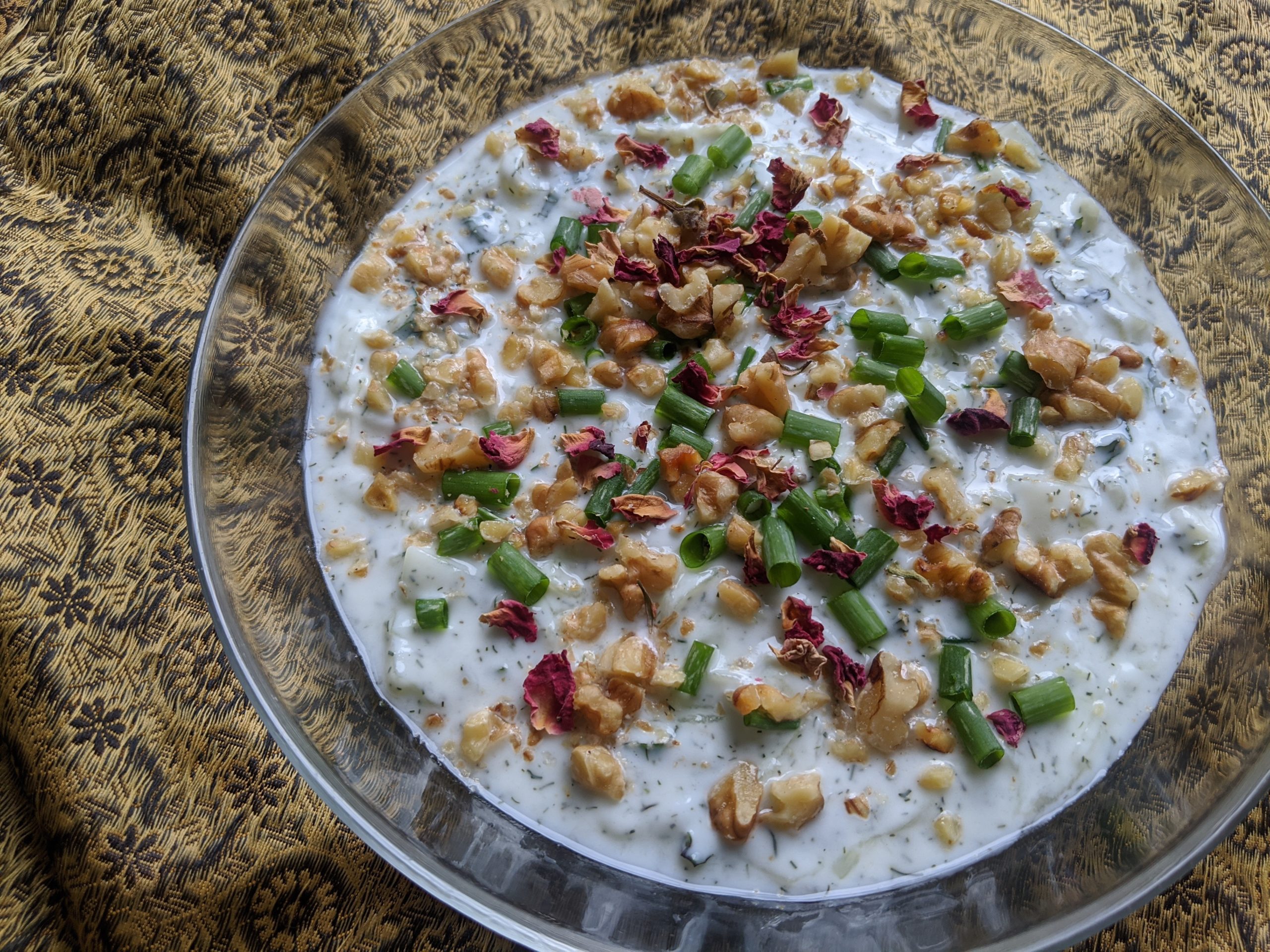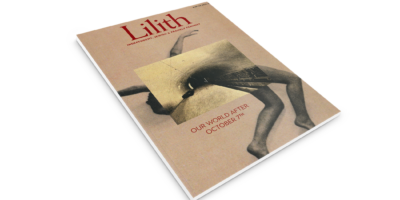
Get Your Chill On
The first cold soup I ever tasted I hated. For years.
How unfortunate that it was introduced to me (dare I say pushed on me?) by the two women I admired most, my mother and my small-but-mighty Russian grandmother. Imagine walking seven long blocks home from elementary school for a tasty lunch, only to be met by a bowl of beet borscht from a jar. Yes, jarred! Two women who made from scratch the hit parade of Ashkenazic food– chicken soup, brisket, tongue, sweetbreads, both potato and noodle kugels, even gefilte fish– loved their industrial borscht, adding sour cream to complete the dish. I gagged trying to get it down, rarely succeeding.
Who can blame me for avoiding the dish for decades? Then about four years ago, a catering client requested I make a cold beet borscht for her 70th birthday party luncheon. I created a recipe that added garlic and carrots to the traditional beets, onion and dill mixture, and made what I thought was an overwhelming amount of the stuff. It disappeared. All of it.
Now I make beet borscht a few times a year. I just don’t call it borscht when serving it to others until they’ve tasted it… It turns out I’m not the only one haunted by bad borscht memories! I’m even sharing the recipe below, confident that most of you will enjoy it.
Many of us know borscht, but not necessarily that it is just one of many cold soups that are very much part of Jewish food traditions. Over the years, I have fallen in love with these soups, from spicy gazpacho to tart cherry and creamy yogurt-cucumber. During hot summer days, these chilled bowls of nourishment are perfect as an appetizer or a light meal with some good bread and maybe a salad.
Among Central European Jews, especially Hungarians and Romanians, stone fruits, like peaches, cherries and plums, sometimes with apples or pears, are cooked in water or wine, with a little sugar and various combinations of cinnamon, cloves, vanilla and lemon juice. Served with sour cream, of course.
Russian Jews favor more savory cold soups. In addition to beet borscht, they are known for schav, a soup made from sorrel. Also called sour grass, sorrel is a tangy herb with leaves that look like spinach and the same oxalic acid that gives rhubarb its tartness. Not only flavorful, sorrel aids digestion among other healing qualities. Poor Jewish peasants usually added potatoes and sour cream to make a hearty meal with dark bread.
Cold soups aren’t just an Ashkenazi thing, but part of Jewish cuisine around the world. Based on local ingredients and tastes, they are especially suited for Shabbat, when observant Jews don’t cook. But really, any warm day is perfect for something like chilled yogurt and cucumber soup, which has been eaten as long as remembered in Syria, Persian/Iran, Iraq, Turkey and throughout the Middle East.
The basic mixture is yogurt (homemade once upon a time), cucumbers and garlic, diluted with a little milk, buttermilk, or water. In Persia, additions might include seedless grapes, walnuts, rose petals and more herbs like cilantro, basil and parsley. Others might use raisins, pickled cucumbers, scallion, dill, chopped tomatoes…the options are endless. An Egyptian version cooks onion, spinach and rice together, then cools before mixing in the yogurt, cucumber and mint. My version (below) is closer to the Turkish with lots of mint and dill. It makes me think about my ancestors on my father’s side who lived in the Ottoman Empire for centuries after fleeing the Inquisition.
Those ancestors also embraced the tomato, which arrived in Spain from South America in 1523 and spread east throughout Europe and the Middle East. Other Europeans first thought this fruit was poisonous, but Jews of the Ottoman Empire quickly took to adding it to soups, stews, sauces and salads.
In Spain, two favorites developed based on the country’s delicious bounty of warm-weather-loving tomatoes – gazpacho and salmorejo. Gazpacho is well known in much of the world for its flavorful combination of vegetables. The less well known salmorejo has an interesting tie to Spain’s Jews. The Inquisition was still raging when the tomato arrived in Spain, with the focus being on routing out conversos, or New Christians, who were secretly holding onto their Judaism. So, as happened with many dishes at the time, ham was added as a garnish to the soup, which would force people to either eat it as any good Christian would, or suffer the horrible consequences.
Fortunately, there were no such consequences for not eating borscht for so many years. Now, I really am glad I grew up and learned to like homemade borscht and other cold soups that put a delicious chill in my summer.
***
CHILLED BEET SOUP (aka Borscht)
Red beets stain, so wear a latex or other cooking gloves when peeling and chopping. Also, use a glass or hard plastic cutting board or one you don’t mind getting stained red, or chop the beets on a glass plate. A beautiful way to serve this dish is to prepare each color of beets separately, then carefully add some of each color to each bowl, keeping the colors separate, and garnish as you like.
Serves 6-8
- 1 1/2 pounds red or golden beets
- 2-3 carrots, about 1 cup chopped
- 1 medium onion, about 1 1/2 cup chopped
- 1-2 cloves garlic, chopped
- 5-6 cups vegetable broth or water
- 3 tablespoons chopped fresh dill or 1 heaping tablespoon dried dill
- 1/2 teaspoon salt or to taste
- 1/4 teaspoon pepper or to taste
- Pinch or two of ground cloves (optional)
- About 4 tablespoons sour cream or plain yogurt
- Garnish options: chopped fresh chives, diced tops of green onions, dill sprigs, chopped hard boiled eggs
Wash the beets and carrots well. No need to peel, just cut off any roots, stems and rough parts. Chop the beets, carrots and onion to roughly about 1-inch size. Put in a medium-sized pot with the broth or water, garlic, dill and cloves if using. Bring to boil. Reduce heat to medium-low, cover and simmer until vegetables are very tender, about 45 minutes. Let cool.
Puree to desired consistency in the pot with a stick blender or in batches in a Put into a large bowl or container, preferably glass. Thin with additional broth or water if desired. Season with more salt and pepper to taste. Cover and chill until very cold, at least 3 hours or overnight. The soup can be prepared up to 3 days ahead and kept refrigerated until serving.
Ladle soup into bowls. Add a dollop of sour cream or yogurt and garnish as desired. For another garnish option, mix some dried or chopped fresh dill into the sour cream or yogurt and let sit in the fridge until time to dollop and decorate. For an artier look that will make people think you really know what you’re doing, slightly thin the sour cream or yogurt with a little milk, just enough to squeeze out of a squeeze bottle with a pointed opening or a small plastic locking bag with a tiny bit of a corner cut off. Squeeze the sour cream or yogurt gently and evenly in a large spiral on top of the soup, add a sprinkle of chives or green onions and serve to an appreciative table.
***
CHILLED CUCUMBER-YOGURT SOUP
Traditionally, this soup is made with full-fat yogurt (homemade, of course) thinned with milk, buttermilk or water. You can use low-fat or non-fat yogurt with the olive oil adding the rich mouth feel. No matter what, it’s satisfyingly delicious with health benefits of gut-enhancing probiotics while cucumbers are good for cleansing, including your liver. The soup makes a refreshing starter course or light meal. It’s also good served over rice, quinoa or bulgur. By the way, if you make this recipe with thicker Greek yogurt, you end up with tzitziki that you can serve with crudité and crusty bread or fresh flatbread as part of a mezze or appetizer course.
Makes 6 to 8 servings
- 1 1/2 pounds cucumbers
- 2-3 cloves garlic, grated or pressed
- 4 cups plain yogurt (not Greek), chilled
- 1-2 tablespoons good quality olive oil
- 1/2-1 teaspoon sea salt or table salt
- 1/2-1 cup ice cold water or milk plus the liquid from the cucumbers
- 1/3 cup chopped fresh dill or 2 tablespoons dried, or to taste
- 1/2 cup chopped fresh mint or 2 tablespoons dried, or to taste
- Garnishes: a drizzle of olive oil, sprinkle of Aleppo pepper or sumac, sliced or chopped cucumber, crumbled feta, chopped red onion or scallions, chopped toasted walnuts
For slicing cucumbers, peel and cut in half the long way and seed with a spoon. For Persian or hothouse/European cucumbers, if not waxed, peeling is optional and seeding
Finely dice or grate cucumbers on the large holes of a box grater into a bowl, or do some of each method for a more complex texture. Save the liquid along with the cucumber.
Put the cucumbers with their liquid in a mixing bowl. Add the yogurt, garlic, olive oil and salt. Stir everything together. Thin gradually with water or milk to the desired consistency. Add the mint and dill. Stir, taste and adjust both taste and consistency as desired.
Refrigerate at least an hour, more is better, to allow the flavors to blend and the soup to get really cold. A few minutes before serving, put into individual bowls and garnish as desired. If it’s really hot and you’re eating outside, you can ladle the soup over an ice cube in each bowl. If you’re going to do that, take it into account when thinning the soup.
For Persian variation: stir in 1/2 cup toasted walnuts, finely chopped, 1/2 cup golden raisins or grapes and 1/2 cup chopped parsley and/or basil. Garnish with edible rose petals.
***
SALMOREJO
Taking advantage of Spain’s bountiful tomatoes, salmorejo is also one of those recipes, like bread salad from Italy and fattoush from Northern Lebanon, that are great ways to use up old bread. Usually served with a splash of sherry or wine vinegar, I have added my own twist by using one of my favorite ingredients, pomegranate molasses, instead of vinegar for a more complex sweet tartness.
Serves 4
- About 2 1/2 pounds ripe tomatoes
- 2 cups white bread without the crust (most of the soft insides of a baguette)
- 1-2 cloves garlic, grated or pressed
- 1 teaspoon sherry vinegar or red wine vinegar or 1-2 teaspoons pomegranate molasses
- 1/2 teaspoon salt or to taste
- 1/4-1/2 cup good olive oil
- 2-4 hard-boiled eggs, chopped or sliced
- Garnishes: chopped chives, pomegranate molasses and/or olive oil drizzles
Core, chop and seed the tomatoes. Working in two batches, process half the tomatoes in a blender about 30 seconds to break down. Add half the bread, pushing it fully into the tomatoes to start to soften. After a minute, add half the garlic, vinegar or pomegranate molasses and salt. Process at high speed until very smooth, usually about 1 minute. Keep the blender running as you drizzle in about 2 tablespoons olive oil. When well blended, stop to taste. Adjust the olive oil and salt. Blend again, adding more olive oil with the blender running as desired. The soup should be very smooth. Put the soup into a large bowl or pitcher. Repeat with the rest of the ingredients. Cover and refrigerate until it is very cold, at least 2 hours.
To serve, divide the soup among 4 wide bowls. Garnish with chopped eggs and other options as desired.
***
Susan Barocas is a writer, chef, cooking instructor and speaker who served as guest chef for three Obama White House Seders. All recipes are the property of Susan Barocas and may not be reprinted or shared without her permission.



